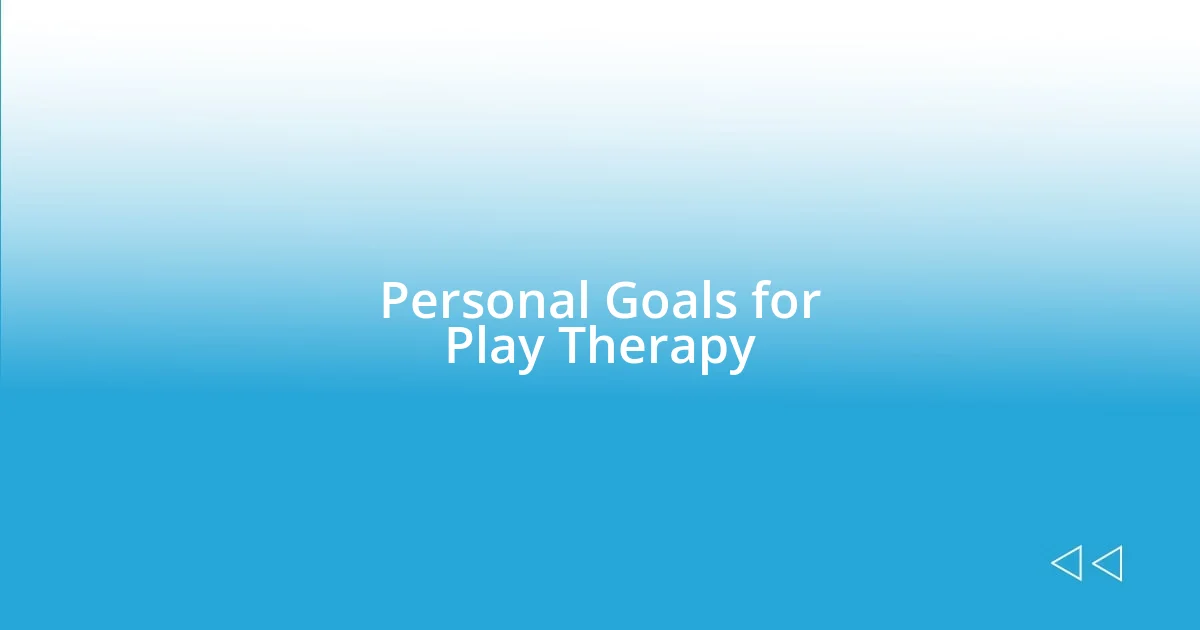Key takeaways:
- Play therapy offers adults a creative and safe way to express complex emotions and explore past traumas, leading to personal insights and connections.
- Setting clear personal goals, such as building emotional resilience and reconnecting with playfulness, enhances the therapeutic process and tracks progress effectively.
- Overcoming challenges in play therapy, such as confronting uncomfortable emotions and navigating uncertainty, can lead to significant personal growth and deeper self-discovery.

Understanding Play Therapy Benefits
Play therapy isn’t just for children; it offers significant benefits for adults too. I remember a time when I felt completely overwhelmed by my emotions. Engaging in play therapy allowed me to express those feelings in a way that was less intimidating and more creative. It’s fascinating how a simple act like drawing or using figurines can help us process complex emotions—have you ever noticed how childhood toys can evoke deep memories?
Through play therapy, I found a safe space to explore and address trauma. One session, I used puppets to enact a dialogue I wished I could have had in real life. The release of pent-up feelings through this playful interaction felt liberating. Isn’t it intriguing how something that seems so lighthearted can lead to profound insights about our inner selves?
Moreover, play therapy fosters adult connection and self-discovery. I found myself forging deeper connections with both the therapist and my inner child. It highlighted for me the importance of creativity in healing; after all, don’t we all deserve the chance to play and rediscover joy in our lives, regardless of age?

How Play Therapy Works
Play therapy works by tapping into the natural ways adults express themselves—most notably, through creativity and imagination. For me, it was like unearthing a long-forgotten treasure chest of emotions. I recall a session where I experimented with clay, molding shapes that mirrored my anxiety. Each squeeze and stretch of the material revealed unspoken feelings, making the abstract tangible.
Here are some key elements of how play therapy functions for adults:
-
Nonverbal Expression: Engaging in playful activities allows clients to express emotions that are hard to verbalize.
-
Symbolism: Play often incorporates objects that represent deeper issues, helping to break down complex feelings.
-
Safe Environment: The therapeutic setting provides a secure space for vulnerability, encouraging authentic exploration.
-
Reflection: Sessions often lead to discussions about the play itself, unveiling insights into one’s behavior and emotional state.
In my experience, I’ve seen how these playful modalities can serve as bridges to understanding. Just the act of painting during one session allowed me to unravel emotions hidden beneath layers of stress. It’s a beautiful reminder that sometimes, the simplest acts can unlock the most profound parts of ourselves.

Personal Goals for Play Therapy
Set personal goals before starting play therapy. This not only provides direction but also allows for tracking progress. I remember sitting down before a session, contemplating what I wanted to achieve. For instance, my goal was to explore my childhood memories and see how they influenced my adult relationships. This clarity turned each session into a meaningful journey.
One of my most important personal goals was to build emotional resilience. During the process, I set specific objectives, like expressing one positive and one negative emotion through art each week. It felt empowering to witness my progress, understanding that facing difficult feelings, rather than avoiding them, was crucial to my healing. Have you ever considered how establishing clear intentions can sharpen your focus and enhance your experience?
Lastly, I aimed to discover a sense of playfulness I had lost touch with. Each session became an opportunity to reconnect with my creative side. I still recall laughing over silly drawings and how liberating it felt to loosen up. Dedicating time to these goals turned therapy into a delightful exploration of myself, blending healing with an element of joy.
| Personal Goal | Description |
|---|---|
| Explore Childhood Memories | Understanding how past experiences impact current behavior. |
| Build Emotional Resilience | Practicing the expression of both positive and negative emotions through play. |
| Reconnect with Playfulness | Finding joy and creativity in everyday life and therapy. |

Techniques Used in Play Therapy
When I first encountered nonverbal expression in play therapy, it was liberating. I remember sitting in front of a canvas, allowing my brush to dance wildly across the surface without concern for the final product. This instinctive movement let my emotions spill out in colors and strokes, illustrating my inner turmoil more accurately than words ever could. Isn’t it interesting how sometimes we need to step outside of our comfort zone to actually communicate what’s going on inside?
Symbolism played a crucial role in many of my sessions. One time, I found a small wooden figure that represented a hurt part of me. As I painted it, I realized how the act of creating something tangible eased the weight of the memories attached to it. I was not just facing my fears; I was transforming them into art. Have you ever noticed how objects can carry such profound meaning when viewed through a personal lens?
In a secure environment, I was finally able to let the walls down. I still vividly recall a moment where I simply sat with a pile of soft toys, talking to each one about my day. It felt silly at first, but with each plush friend I confided in, I could feel the tension lift. This kind of playful interaction fostered an authenticity I hadn’t tapped into for years. It makes you wonder; could play really be a powerful pathway to emotional healing?

Challenges Faced in Play Therapy
Engaging in play therapy wasn’t without its obstacles. Initially, I found it challenging to fully embrace the play aspect. I often felt a sense of resistance, as if I were stepping back into childhood yet bearing the weight of adult expectations. Have you ever felt caught between two worlds? That push and pull made me question whether it was acceptable for an adult to just ‘play.’ But I realized that this inner conflict was precisely what I needed to navigate in therapy, unlocking a deeper understanding of my fears around vulnerability.
Another challenge emerged when I had to confront the uncomfortable emotions that surfaced during sessions. There were days when I would leave feeling emotionally drained because, let’s face it, staring into the mirror of our inner selves isn’t always pretty. I remember one particular session where I was overwhelmed by a wave of sadness while creating a collage. It struck me how essential it was to sit with those feelings rather than shy away from them. I began to understand that these moments were pivotal in my growth, despite feeling like I was trudging through thick mud at times.
Then, of course, there were moments when I simply didn’t know what to do next in my sessions. I often sat staring blankly at the materials laid out before me. I’d question, “How can something so simple feel so daunting?” Yet, I learned that the very art of uncertainty could itself spark creativity. Instead of pressuring myself for progress, I started to view these pauses as opportunities to breathe and listen to what my heart really wanted to express. This shift in mindset opened doors to insights I hadn’t anticipated and deepened my connection to the play process. How liberating it became to realize that confusion doesn’t have to be a stop sign, but a chance for exploration!

Measuring Progress in Therapy
Measuring progress in therapy can feel like navigating uncharted waters. During my sessions, I often turned to my therapist for feedback about my growth. I recall one instance where she encouraged me to reflect on my reactions to different activities. As we discussed my emotional shifts, I realized that recognizing my feelings was a significant step in my healing journey. When have you taken a moment to notice how you’ve changed?
Another way I gauged progress was by revisiting previous creations that I’d made in sessions. There was a time I had a burst of creativity, crafting a chaotic art piece full of splattered paint and rough edges. Days later, I sat before it with a newfound sense of acceptance. Instead of annoyance at the disorder, I saw beauty reflecting my various emotions. I can’t help but wonder—how might revisiting old items help you gauge your own growth over time?
Surprisingly, conversations with my loved ones served as a revealing mirror of my progress, too. Their feedback about my increased openness reminded me how far I had come in articulating my feelings. There were nights when I went out with friends, sharing both laughter and vulnerability, and the change felt palpable. Realizing that others could see my transformation made me ponder—how do our relationships evolve alongside our personal journeys?

Personal Reflections on the Process
The process of play therapy felt like peeling back layers of an onion. There were moments when I discovered emotions I didn’t even know I had tucked away. For instance, while working with clay, I molded a figure that represented my childhood self. Suddenly, I was overwhelmed by a flood of nostalgia mixed with regret. Why do we often ignore the voices of our past? I realized that embracing these forgotten parts helped me connect the dots of my current feelings, allowing healing to take root.
As I engaged more freely in sessions, I found myself laughing—really laughing—at the silliness of the activities. Once, I tossed a colorful scarf across the room and reveled in the joy of spontaneity. It dawned on me how often I confined myself to seriousness as an adult. Have you ever caught yourself forgetting how to have fun? This realization opened a channel to explore creativity and joy, reminding me that play is just as essential at any age.
Reflecting on my journey, I often marveled at the nuance of emotional exploration. I remember one session where I sat silently for what felt like an eternity. The stillness was uncomfortable, almost daunting. But in that quiet space, a thought emerged that changed everything: silence can be just as powerful as action. It prompted me to dive deeper into my feelings rather than flee from them. Isn’t it fascinating how sometimes the most profound revelations come from simply allowing ourselves to be? This new understanding reshaped my experience in therapy, highlighting the power of being present in the process.
















